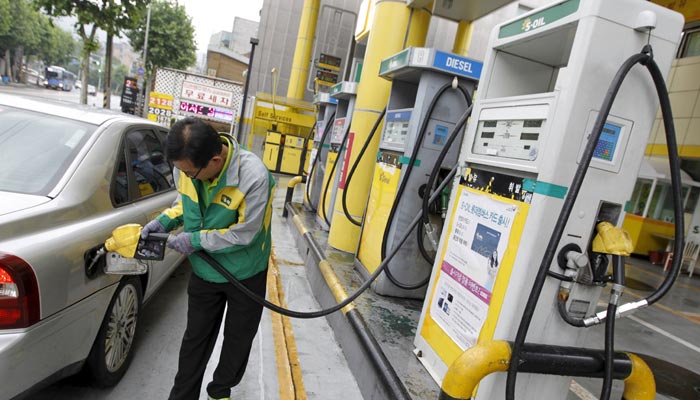An employee fills the tank of a car at a petrol station in Seoul in this 2011 file photo. Analysts expect oil prices to drop further.
Reuters/Singapore
Brent crude fell to levels last seen in 2004 on Monday, dropping under the lows hit during the 2008 financial crisis on renewed worries over an oil glut, with analysts saying prices could head lower still.
Global production remains at or near record highs and new supply looms from Iran and the US. Crude markets are also under pressure following last week's US interest rate hike and from signs of growing US stockpiles even as more drilling rigs are deployed.
Brent futures fell around 2% to as low as $36.06 per barrel on Monday, the weakest since July 2004 and below even the $36.20 mark reached during the peak of the global financial crisis of 2008.
US West Texas Intermediate (WTI) futures dropped 41 cents to $34.32 per barrel, holding near last week's 2015 lows.
Due to production far outpacing demand, the benchmarks have fallen more than two-thirds since mid-2014, when the rout began, and analysts said there was an increasing risk of further falls.
"There is further downside risk to prices," Barclays said on Monday.
Morgan Stanley said that "the hope for a rebalancing in 2016 continues to suffer serious setbacks". It cited US output being "more resilient than most models originally indicated", the return of at least 500,000 barrels per day (bpd) from Iran in the first quarter of 2016, rising Libyan production and slowing demand growth as the main reasons for a continuing supply glut.
Global oversupply
Beyond the unexpected gain in the US oil rig count by 17 to 541, the strength in the US dollar following last week's interest rate hike - which makes oil more expensive for countries using different currencies - also weighed on prices.
"The resilient production data reflect rising US crude stockpiles, which have surged to 491mn barrels, the most for this time of year since 1930," ANZ bank said.
The US glut adds to global oversupply as the main producers, Russia and the Organisation of the Petroleum Exporting Countries (Opec), pump hundreds of thousands of barrels of crude every day in excess of demand.
Russian production surpassed 10mn bpd, the highest since the collapse of the Soviet Union, while Opec output also remains near record levels above 31.5mn bpd.
Opec leader Saudi Arabia upped production from 10.226 to 10.276mn bpd between September and October.
Iraq's oil minister Adel Abdul Mahdi told Reuters over the weekend that Opec would stick to its December 4 decision to not limit production despite the drop in prices.
More oil becoming available soon will add to the glut, with Iran hoping to ramp up sales in early 2016 once sanctions against Tehran are lifted.
Iran will export most of its enriched uranium to Russia in coming days as it rushes to implement a nuclear deal and secure relief from international sanctions.
This comes only days after the US voted to lift a 40-year-old ban on crude exports, which could see some production released on the global market.



